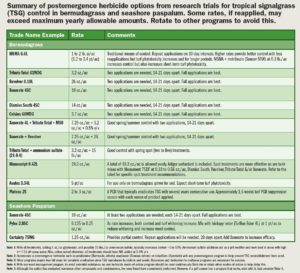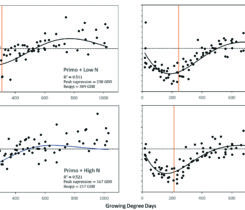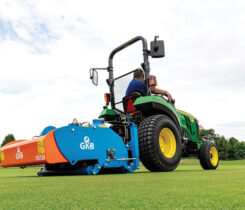Conquer tropical signalgrass: Strategies to overcome this persistent weed

(Fig. 1) Tropical signalgrass is a major problem in tropical and subtropical turfgrasses. With the loss of the effective organic arsenical (e.g., monosodium methanearsonate) herbicides, it has exploded in the past 10 years in areas like Florida. It spreads by seeds and stolons, often forming large, unsightly patches. (Photo: Bert McCarty)
Tropical signalgrass (Urochloa subquadripara; formerly Braciaria subquadripara), is a warm-season perennial grass that spreads by stolons and seeds (Figure 1). The common name is from its seedhead producing two to seven branches angled to resemble a signal flag (Figure 2). It is native to tropical Asia, and being a warm-season perennial, it dies back with frost, regenerating itself from both stolons and seeds.
In the U.S., it currently occurs from coastal South Carolina through Texas with isolated stands in other states, but the majority of the problem is throughout the state of Florida. In areas lacking frost, such as much of Florida, tropical signalgrass (TSG) remains green year-round, forming large patches from stoloniferous growth.
Germination for TSG occurs when soil temperatures reach 77 degrees F (25 C), and a soil pH of 5 to 6 is optimal for germination (4). Seed germination requires moisture, and during extended droughts, TSG infestations diminish.
Tropical signalgrass infestation can be minimized by careful mapping of infested areas and recording spray applications to ensure proper herbicide application timing. Sanitation practices to reduce spread should include rinsing mowers between uses, controlling TSG in hard-to-treat areas such as ditches and fence rows and planting with weed-free stock.
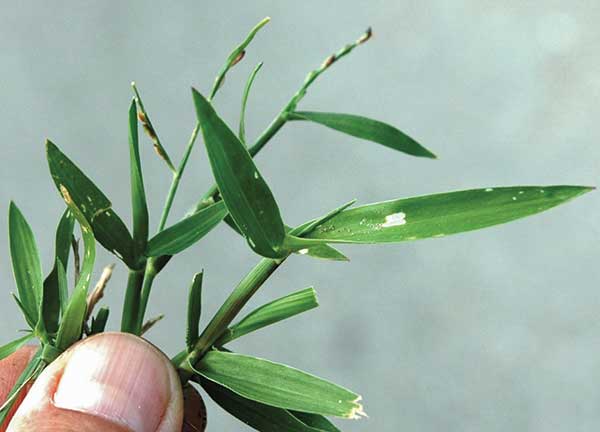
(Fig. 2) Tropical signalgrass leaves and a spikelike seedhead. Signalgrass refers to the right-angle leaves that originate from the stem, resembling a signal flag. (Photo: Bert McCarty)
Attempts to control TSG in St. Augustinegrass (Stenotaphrum secondatum) have primarily been unsuccessful (5). In bermudagrass (Cynodon species), repeat applications of members of the organic arsenical herbicide families traditionally provided acceptable suppression/control. However, since the prohibition of these products for use on turf in Florida, an explosion of TSG infestations has occurred in that state.
Previous research identified several herbicide options with postemergence TSG activity (1, 3). However, these can be expensive and tend to work best with fall applications. This timing interferes with ryegrass overseeding and does not allow sufficient time for the bermudagrass to cover voids left by dead TSG plants.
This article covers our 10-plus year experience at Clemson University on battling this weed with the latest management practices that have proven successful for TSG control.
Options for controlling tropical signalgrass
For TSG control in bermudagrass, several options exist depending on costs, how quickly control is desired, turf tolerance and the season control is attempted (Figure 3). A summary of these options is presented in Table 1.
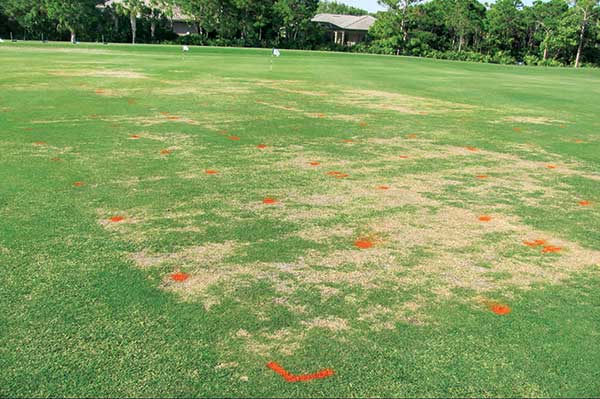
(Fig. 3) Shown is an effective tropical signalgrass control with several herbicide combinations. Control requires persistence with most products over several years. (Photo: Bert McCarty)
Many of the products listed perform best in combination with a differ mode of action herbicide. As noted in the table, fall applications provide the best control at the lowest price. However, these can interfere with overseeding, and voids created by control may have insufficient time to recover before winter.
Spring, as well as summer options, are generally less effective, requiring multiple applications and increasing turf phytotoxicity potential.
The cheapest option is using Plateau, a plant growth regulator (PGR), but control will be the slowest, requiring at least two years of continuous use. In addition, with persistent use, Plateau typically controls many sedges and broadleaf weeds, releasing bermudagrass and allowing it to become the dominant species again. Plateau, like most PGRs, is a program requiring repeat applications throughout the bermudagrass growing season. If applications cease, the rebound effect will occur, resulting in a major flush of bermudagrass growth, leading to excessive scalping and weaker root systems.
For TSG control in seashore paspalum (Paspalum vaginatum), options are more restrictive both in terms of weed control efficiency and turf phytotoxicity (Table 1). Xonerate is probably the most effective option in paspalum but will need repeat applications and currently is the costliest.
Certainty provides approximately 70 percent control with a single application; thus, it will require repeat applications. Pylex is a tricky product because weed control improves with increasing use rate, but so does turf whitening. For many Florida golf courses, summer turf phytotoxicity is somewhat acceptable as sufficient time occurs before peak play resumes in fall. With seashore paspalum, an additional option is to apply salt as a burndown product. Though rarely lethal, it does burn TSG down until fresh water such as rainfall flushes the salts, leading to regrowth.
Conclusions
Our research program at Clemson University has evaluated numerous herbicides and combinations over the past 10 years. No particular program will satisfy every course as acceptable herbicide costs, and turf tolerance will vary considerably.
Overall, fall applications are most effective, though, in many situations, fall applications interfere with fall overseeding or do not allow sufficient time for turf recovery before winter. All products and combinations will require multiple applications to achieve adequate control. Tank mixing glyphosate 4L at 5 ounces per acre and/ or ammonium sulfate (21-0-0) at 15 pounds per acre often improves control by five to 10 percent. To lengthen control, include a preemergence herbicide such as indaziflam, oxadiazon or prodiamine.
Research Takeaways
Tropical signalgrass is a warm-season perennial grass that spreads by stolons or seeds and occurs when soil temperatures reach 77 degrees F (25 degrees C).
Herbicide application timing is improved with careful mapping of infested areas and recording spray applications.
Fall herbicide applications are most effective, though, in many situations, they interfere with fall overseeding or do not allow sufficient time for turf recovery before winter.
All products and combinations will require multiple applications to achieve adequate control.
To lengthen control, include a preemergence herbicide such a indaziflam, oxadiazon or prodiamine.
Acknowledgements
Sincere appreciation to Bob Cross, Ph.D., for his critical review of this article.
References
1. Cross, R.B., L.B. McCarty, and A.G. Estes. 2016. Postemergence tropical signalgrass (Urochloa subquadripara) control with nonorganic arsenical herbicides. Weed Technology 30(3):815-821.
2. McCarty, L.B.J, and D. Hall, et al. 2018. Common Weeds and Wildflowers. Clemson Univ. Publication Services, Clemson, SC. 423pp.
3. McCarty, L.B., and A.E. Estes. 2014. Tropical signalgrass control. Golf Course Management 82(4):80-85.
4. Teuton, T.C., C.L. Main, T.C. Mueller et al. 2005. Prediction modeling for tropical signalgrass (Urochloa subquadripara) emergence in Florida. Online. Applied Turfgrass Science doi:10.1094/ATS-2005-042501-BR.
5. Teuton, T.C., J.B. Unruh, B.J. Brecke, et al. 2004. Tropical signalgrass (Urochloa subquadripara) control with pre-emergence- and post-emergence-applied herbicides. Weed Technology 18:419-425.
Related Articles
Experts’ Insights: Tamping down tropical signalgrass
Manuscript herbicide to control tropical signalgrass and other weeds






